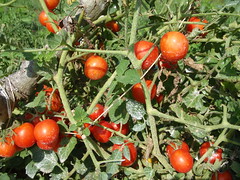 You Say Tomato, I Say Agricultural Disaster, by Dan Barber, NY Times, 8 August 2009.
You Say Tomato, I Say Agricultural Disaster, by Dan Barber, NY Times, 8 August 2009.
According to plant pathologists, this killer round of blight began with a widespread infiltration of the disease in tomato starter plants. Large retailers like Home Depot, Kmart, Lowe’s and Wal-Mart bought starter plants from industrial breeding operations in the South and distributed them throughout the Northeast. (Fungal spores, which can travel up to 40 miles, may also have been dispersed in transit.) Once those infected starter plants arrived at the stores, they were purchased and planted, transferring their pathogens like tiny Trojan horses into backyard and community gardens.Sounds like industrial agricultural distribution strikes again.
The tomatoes pictured grew in sougth Georgia and have no blight, unless you count hornworms, which we do most mornings, picking them off the plants.
